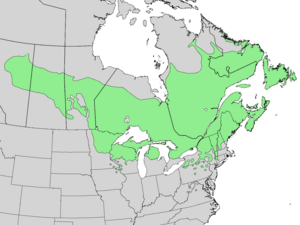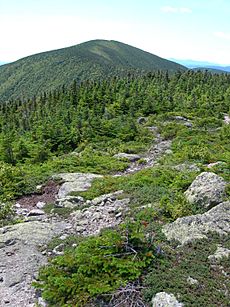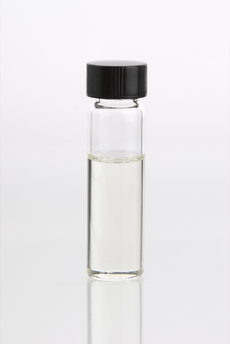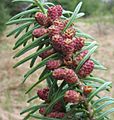Balsam fir facts for kids
Quick facts for kids Balsam fir |
|
|---|---|
 |
|
| Tree with cones | |
| Conservation status | |
| Scientific classification | |
 |
|
| Range | |
| Synonyms | |
|
The balsam fir (scientific name: Abies balsamea) is a type of fir tree. It grows naturally in North America. You can find it across most of eastern and central Canada. It also grows in the northeastern United States. This includes states like Minnesota and Maine. It even reaches south into the Appalachian Mountains in West Virginia.
Contents
What is a Balsam Fir?
The balsam fir is a small to medium-sized evergreen tree. Evergreen means it keeps its green leaves all year. It usually grows about 14–20 metres (46–66 ft) tall. Sometimes, it can reach up to 27 metres (89 ft).
Its top part, called the crown, is shaped like a narrow cone. It has many dense, dark-green leaves. The bark on young trees is smooth and grey. It has small blisters filled with sticky resin. These blisters often spray when they break. Older trees have rougher bark with cracks or scales.
The leaves are flat and look like needles. They are about 15 to 30 mm (5⁄8 to 1+1⁄8 in) long. They are dark green on top. Below, they have two white lines where the tree "breathes." The tip of each needle is slightly notched. The needles grow in a spiral pattern on the branch. But they twist so they look like they are in two rows. Needles higher on the tree are shorter and thicker.
The seed cones stand upright on the branches. They are 40 to 80 mm (1+1⁄2 to 3+1⁄4 in) long and dark purple. When they ripen in September, they turn brown. Then they break apart to release their winged seeds.
Medicinal Uses
For thousands of years, Native Americans used balsam fir for medicine. They used it for healing and therapy. Many animals and humans eat the needles directly from the tree. You can also drink a tea made from the needles. Balsam fir contains vitamin C. This vitamin has been studied for how it helps with infections.
How Balsam Firs Reproduce
Balsam firs have both male and female parts. The male parts usually grow faster than the female parts. Male organs contain tiny sacs called microsporangia. These sacs produce microspores, which become pollen grains. When the male part is ready, it releases the pollen.
The female part is larger than the male. It has scales, and each scale holds two ovules. An ovule is like a tiny egg. Inside the ovule, a special cell forms. This cell divides to create a megaspore. The megaspore then develops into the female reproductive tissue. This tissue contains an egg cell.
When the male part releases pollen, some of it lands on the female part. A pollen tube grows from the pollen grain to the ovule. Finally, the sperm from the pollen meets the egg. This process is called fertilization.
Types of Balsam Fir
There are two main types, or varieties, of balsam fir:
- Abies balsamea var. balsamea (balsam fir) – In this type, the small leaf-like parts under the seed scales are short. You cannot see them when the cones are closed. This variety grows in most of the species' range.
- Abies balsamea var. phanerolepis (bracted balsam fir or Canaan fir) – Here, the leaf-like parts under the seed scales are longer. You can see them even when the cones are closed. This type grows in the southeastern part of the species' range. This goes from southern Quebec to West Virginia. The name Canaan fir comes from a place it grows, the Canaan Valley in West Virginia. Some scientists think this type is a natural mix of balsam fir and Fraser fir.
Where Balsam Firs Grow
Balsam firs like cool places. They prefer an average yearly temperature of 40 °F (4 °C). They also need constant moisture around their roots. They typically grow in four main types of forests:
- Swamp – These forest areas are always wet. Balsam firs always have water here. The ground is covered in mosses. In swamps, balsam firs grow close together and slowly. They tend to be slender.
- Flat – These areas are sometimes called "dry swamps." They drain better than swamps but still hold moisture well. Fern moss covers the ground. Balsam firs grow fast, tall, and large here. They often mix with red spruce trees.
- Hardwood slope – These areas drain well. The ground is often covered with fallen leaves. Balsam firs grow fast, tall, and large here. They grow alongside big hardwood trees. Examples include yellow birch, sugar maple, and beech trees.
- Mountain top – On mountain tops, balsam firs sometimes form "fir waves." They often grow at heights of 760 to 1,520 m (2,500 to 5,000 ft). They can grow in pure groups or with black spruce, white spruce, and trembling aspen trees. Their growth is slow, similar to swamps. This results in slender, short trees. Some low branches touch the ground and can grow roots. This allows them to become new, independent trees.
Animals like moose and deer eat the leaves of balsam firs. American red squirrels, grouse, and pine mice eat the seeds. The tree also provides food for crossbills and chickadees. It gives shelter to moose, snowshoe hares, white-tailed deer, ruffed grouse, and other small animals and birds. Some caterpillars, like the Io moth caterpillar, eat the needles.
Balsam fir is one of the most cold-hardy trees known. It can survive temperatures as low as −45 °C (−49 °F). Some trees even survived being put in liquid nitrogen at −196 °C (−320.8 °F) without harm.
Pests
The balsam fir is a favorite host for the eastern spruce budworm. This insect is a major pest in the eastern United States and Canada. During times when many budworms appear, they can eat a lot of balsam fir needles. This can slow down the tree's growth a lot. It can even kill the tree. For example, in Quebec in 1957, a budworm outbreak killed over 75% of balsam firs in some areas.
How People Use Balsam Firs
Christmas Trees
Both types of balsam fir are very popular as Christmas trees. This is especially true in the northeastern United States. Balsam firs used for Christmas are not taken from wild forests. They are grown on large farms called plantations. The balsam fir is a big export for Quebec and New England.
People love it for its rich green needles. They also like its natural cone shape. Its needles stay on the tree well after it's cut. It is also known as the most fragrant Christmas tree.
Many of these plantations are family farms. They have been passed down for generations. The special ways of growing and shaping the trees are often family secrets. Families like the Rousseau's in Quebec and the Kessler's in New Hampshire have kept these traditions for almost a century.
The balsam fir was chosen six times as the US Capitol Christmas Tree. This happened between 1964 and 2019. In northern Minnesota, Michigan, and Wisconsin, balsam fir branches are used to make Christmas wreaths.
For Gardens
Abies balsamea is also grown as an ornamental tree. This means it's planted in parks and gardens for its beauty. It is very hardy, surviving temperatures of −20 °C (−4 °F) or colder. It needs a protected spot with full sun.
A small type called A. balsamea 'Hudson’ (Hudson fir) only grows to 1 m (3.3 ft) tall. It spreads about 1.5 m (4.9 ft) wide. It has unique blue-green leaves with pale undersides. This type does not grow cones. It has won an award from the Royal Horticultural Society.
Other types of balsam fir grown in gardens include:
- ‘Angustata’
- 'Argentea'
- 'Brachylepis'
- 'Coerulea'
- 'Columnaris'
- 'Glauca'
- 'Globosa'
- 'Longifolia'
- 'Lutescens'
- 'Macrocarpa'
- 'Marginata'
- 'Nana'
- 'Nudicaulis'
- 'Paucifolia'
- 'Prostrata'
- 'Pyramidalis'
- 'Variegata'
- 'Versicolor'
Other Uses of Balsam Fir
The sticky resin from the tree is used to make Canada balsam. This substance was traditionally used as a cold remedy. It was also used as a glue for glasses and parts of optical tools. It helped prepare microscope slides too.
Because it was a traditional medicine and its needles have a lot of ascorbic acid (vitamin C), some historians believe balsam fir was the "aneda" tree. This tree cured scurvy during Jacques Cartier's second trip to Canada.
The wood is cut into lumber for building houses. It is also used for siding. The wood is pulped to make paper. Balsam fir oil is approved by the EPA as a safe way to keep rodents away. The balsam fir is also used as an air freshener and as incense.
Before foam rubber and air mattresses, balsam fir branches were a popular choice for mattresses. This was true in places where there were many trees. Many fir branches naturally curve upwards. This is because snow pushes them down, but new growth reaches for the sun. Layers of fresh, cut branches from small trees made a nice-smelling mattress. It lifted bedding off the wet ground. The curved green branches acted like springs under the soft needles. The top layers of branches were placed with the cut ends facing the ground. This prevented sharp spots and sap from bothering people.
Native American Uses
Native Americans used the balsam fir for many medicinal purposes. The Abenaki people used the gum for minor itches. They also used it as a cleaning ointment for wounds. They would stuff pillows with the leaves, needles, and wood. They believed this helped with many illnesses.
Tree Emblem
The balsam fir is the official provincial tree of New Brunswick in Canada.
Images for kids
-
Seed cones with resin oozing out in the Mingan Archipelago, Quebec
See also
 In Spanish: Abeto balsámico para niños
In Spanish: Abeto balsámico para niños









